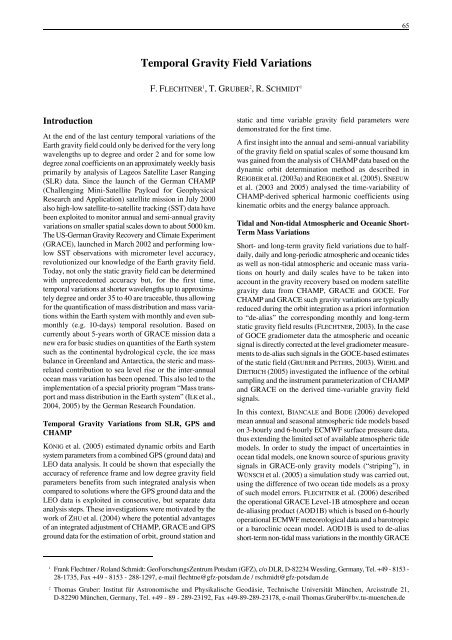NATIONAL REPORT OF THE FEDERAL REPUBLIC OF ... - IAG Office
NATIONAL REPORT OF THE FEDERAL REPUBLIC OF ... - IAG Office
NATIONAL REPORT OF THE FEDERAL REPUBLIC OF ... - IAG Office
You also want an ePaper? Increase the reach of your titles
YUMPU automatically turns print PDFs into web optimized ePapers that Google loves.
Introduction<br />
At the end of the last century temporal variations of the<br />
Earth gravity field could only be derived for the very long<br />
wavelengths up to degree and order 2 and for some low<br />
degree zonal coefficients on an approximately weekly basis<br />
primarily by analysis of Lageos Satellite Laser Ranging<br />
(SLR) data. Since the launch of the German CHAMP<br />
(Challenging Mini-Satellite Payload for Geophysical<br />
Research and Application) satellite mission in July 2000<br />
also high-low satellite-to-satellite tracking (SST) data have<br />
been exploited to monitor annual and semi-annual gravity<br />
variations on smaller spatial scales down to about 5000 km.<br />
The US-German Gravity Recovery and Climate Experiment<br />
(GRACE), launched in March 2002 and performing lowlow<br />
SST observations with micrometer level accuracy,<br />
revolutionized our knowledge of the Earth gravity field.<br />
Today, not only the static gravity field can be determined<br />
with unprecedented accuracy but, for the first time,<br />
temporal variations at shorter wavelengths up to approximately<br />
degree and order 35 to 40 are traceable, thus allowing<br />
for the quantification of mass distribution and mass variations<br />
within the Earth system with monthly and even submonthly<br />
(e.g. 10-days) temporal resolution. Based on<br />
currently about 5-years worth of GRACE mission data a<br />
new era for basic studies on quantities of the Earth system<br />
such as the continental hydrological cycle, the ice mass<br />
balance in Greenland and Antarctica, the steric and massrelated<br />
contribution to sea level rise or the inter-annual<br />
ocean mass variation has been opened. This also led to the<br />
implementation of a special priority program “Mass transport<br />
and mass distribution in the Earth system” (ILK et al.,<br />
2004, 2005) by the German Research Foundation.<br />
Temporal Gravity Variations from SLR, GPS and<br />
CHAMP<br />
KÖNIG et al. (2005) estimated dynamic orbits and Earth<br />
system parameters from a combined GPS (ground data) and<br />
LEO data analysis. It could be shown that especially the<br />
accuracy of reference frame and low degree gravity field<br />
parameters benefits from such integrated analysis when<br />
compared to solutions where the GPS ground data and the<br />
LEO data is exploited in consecutive, but separate data<br />
analysis steps. These investigations were motivated by the<br />
work of ZHU et al. (2004) where the potential advantages<br />
of an integrated adjustment of CHAMP, GRACE and GPS<br />
ground data for the estimation of orbit, ground station and<br />
Temporal Gravity Field Variations<br />
F. FLECHTNER 1 , T. GRUBER 2 , R. SCHMIDT 1<br />
1 Frank Flechtner / Roland Schmidt: GeoForschungsZentrum Potsdam (GFZ), c/o DLR, D-82234 Wessling, Germany, Tel. +49 - 8153 -<br />
28-1735, Fax +49 - 8153 - 288-1297, e-mail flechtne@gfz-potsdam.de / rschmidt@gfz-potsdam.de<br />
2 Thomas Gruber: Institut für Astronomische und Physikalische Geodäsie, Technische Universität München, Arcisstraße 21,<br />
D-82290 München, Germany, Tel. +49 - 89 - 289-23192, Fax +49-89-289-23178, e-mail Thomas.Gruber@bv.tu-muenchen.de<br />
65<br />
static and time variable gravity field parameters were<br />
demonstrated for the first time.<br />
A first insight into the annual and semi-annual variability<br />
of the gravity field on spatial scales of some thousand km<br />
was gained from the analysis of CHAMP data based on the<br />
dynamic orbit determination method as described in<br />
REIGBER et al. (2003a) and REIGBER et al. (2005). SNEEUW<br />
et al. (2003 and 2005) analysed the time-variability of<br />
CHAMP-derived spherical harmonic coefficients using<br />
kinematic orbits and the energy balance approach.<br />
Tidal and Non-tidal Atmospheric and Oceanic Short-<br />
Term Mass Variations<br />
Short- and long-term gravity field variations due to halfdaily,<br />
daily and long-periodic atmospheric and oceanic tides<br />
as well as non-tidal atmospheric and oceanic mass variations<br />
on hourly and daily scales have to be taken into<br />
account in the gravity recovery based on modern satellite<br />
gravity data from CHAMP, GRACE and GOCE. For<br />
CHAMP and GRACE such gravity variations are typically<br />
reduced during the orbit integration as a priori information<br />
to “de-alias” the corresponding monthly and long-term<br />
static gravity field results (FLECHTNER, 2003). In the case<br />
of GOCE gradiometer data the atmospheric and oceanic<br />
signal is directly corrected at the level gradiometer measurements<br />
to de-alias such signals in the GOCE-based estimates<br />
of the static field (GRUBER and PETERS, 2003). WIEHL and<br />
DIETRICH (2005) investigated the influence of the orbital<br />
sampling and the instrument parameterization of CHAMP<br />
and GRACE on the derived time-variable gravity field<br />
signals.<br />
In this context, BIANCALE and BODE (2006) developed<br />
mean annual and seasonal atmospheric tide models based<br />
on 3-hourly and 6-hourly ECMWF surface pressure data,<br />
thus extending the limited set of available atmospheric tide<br />
models. In order to study the impact of uncertainties in<br />
ocean tidal models, one known source of spurious gravity<br />
signals in GRACE-only gravity models (“striping”), in<br />
WÜNSCH et al. (2005) a simulation study was carried out,<br />
using the difference of two ocean tide models as a proxy<br />
of such model errors. FLECHTNER et al. (2006) described<br />
the operational GRACE Level-1B atmosphere and ocean<br />
de-aliasing product (AOD1B) which is based on 6-hourly<br />
operational ECMWF meteorological data and a barotropic<br />
or a baroclinic ocean model. AOD1B is used to de-alias<br />
short-term non-tidal mass variations in the monthly GRACE











